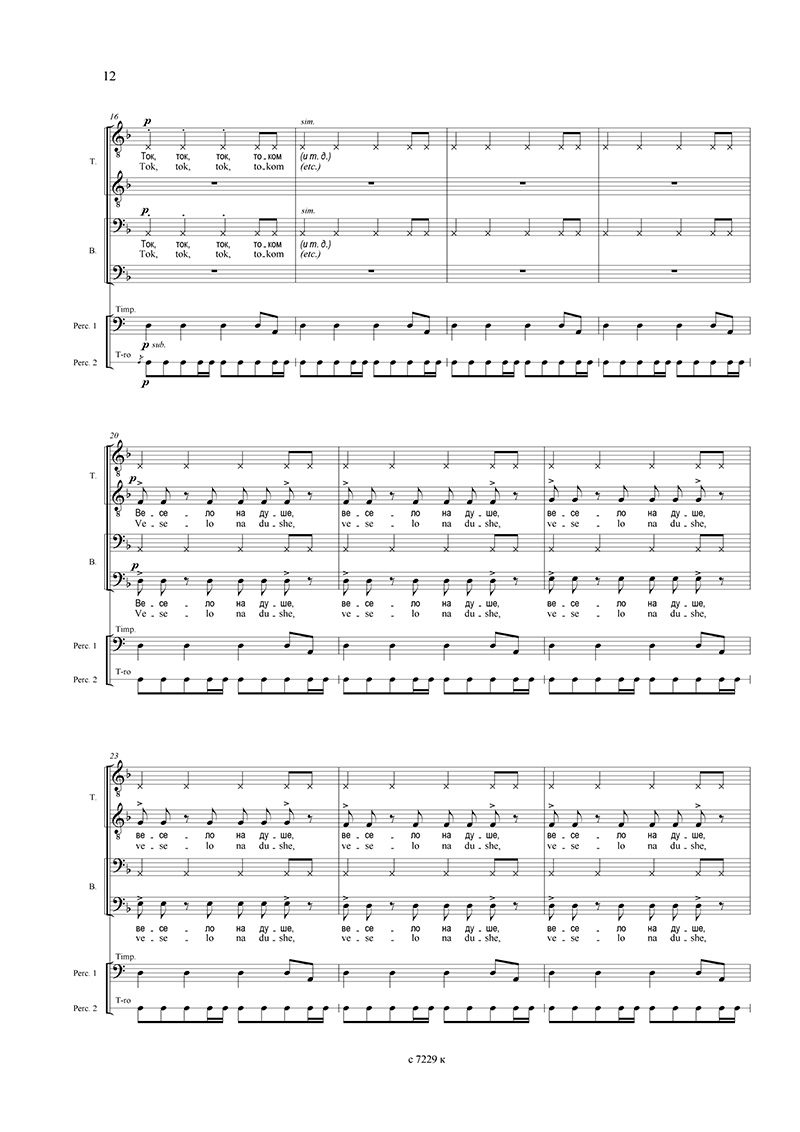
Gavrilin V. Chimes. Choral symphony-action. Score
- Author:
- Gavrilin V.
- Author (full):
- Valery Gavrilin
- Title (full):
- Chimes. On reading V. Shukshyn. Choral symphony-action for soloists, big choir, hautboy and percussions. Score
- Number of pages:
- 144
«According to the main artistic conception the composition is to express the whole people’s spiritual life through the single man’s lot — from birth, through childhood, youth and maturity to the end. Endless way, which people go along, generation after generation. The images of the road, the way, the river of life are the leading ones in this composition». Thus the composer indicated his choral symphony’s «Сhimes» idea and plot in his letter-response to the musicologist T. А. Grum-Grzhimailo two years before its performance. This confession reveals the artist’s long and profound thoughts about the modern Russia, about his art’s inspiration.
I think, here the creative impetus for inventing something unprecedented in composition’s genre and substantial aspect is quite visible.
Valery Gavrilin’s music has really won people’s acknowledgement, deserved by him. Already during the period of his individual musical style formation the composer declared his main principle. He boldly decided not to adhere the ordinary way of only technological means’ innovations in his manner of composing. Thus he denied the blind adoption of the already worked out methods by the «avantgarde» European music of the 20ieth century. Gavrilin wanted not only outward features of modernity, such as sound, facture, form, he tried to find the new spiritual satiation in art, that could attract either the temptated music experts, or, mainly, the mere listeners. Gavrilin aspired to attain originality and novelty in his art by the attention to the kind of images, which was utterly neglected by the «high style» musicians.
That was the spiritual world of so-called common people, seeming to be quite inconspicuous, however, endowed with spiritual generosity and ample authentic expressive feelings. The composer was eager to address the principles, differing from the other artists’ aesthetic principles of depicting the contemporary characters. The initial impetus for the composer occurred to be the main music feature — to express human soul’s emotions in process, which is impossible to be reflected either by words, or gesture, or anyhow else, but only by the means of truthful and close to life musical intonation. The intrinsicality and sincerity were searched by Gavrilin and very often discovered in the modern folklore, in natural practice of traditional music making in the village or city. He tried to comprehend his compatriots’ spiritual expectations, understanding simultaneously the Russian people’s state of mind. He hoped to amalgamate with the people in the idea of life’s essence, truthful and wholesome moral relations, making clear their necessities, concerning the artistic fundamental features. This exact sphere was intended by Gavrilin for his music’s existence and development.
Almost twenty years passed since Gavrilin created the «Chimes» score (composer marked the time of its creation 1981–82, and in one of his interviews he admitted to have been writing the composition during seven years).
The première took place in 1984. The work was performed by the Moscow Chamber choir directed by the distinguished choir-master V. N. Minin (the students of the Moscow Gnesins’ Musical-Pedagogical Institute choir chamber cast took part in it). I remember the triumphant Leningrad première of the «Chimes», and the same time I was one of the first ones to respond rapturously on the pages of the paper «Sovietskaya Rossiya» («The Soviet Russia»). In 1985 this composition was marked by the State prize of the USSR. Soon the score was published and discs appeared (they were not lying for a long time on book-shops’ shelves).
Today it’s time to conclude, the symphony-action by Gavrilin did really prove its vitality. Now we live in the other sort of Russia and it’s especially valuable and interesting for us to know the talented artist’s (having lived at the last third of the 20ieth century) view to this country’s soul. Gavrilin’s choral symphony is demonstrated in new interpretation. Many times a year it may be heard in original stage performing by the glorious Academical Kapelle Choir of StPetersburg directed by V. A. Chernushenko (alas, the composer couldn’t already witness this wonderful interpretation of his work). The «Chimes» excerpts are used to be performed by other various choirs, including the foreign ones. Gavrilin’s compositions are popular also among choir classes, students, musicologists and just music lovers. Having become the utmostly important phase along the Russian music culture achievements, the symphony-action entered the educational programmes of different subjects in musical colleges and conservatoires. Hence the Collected Works by Gavrilin are decided to be opened by the «Chimes» score, his mostly significant composition. This edition is based on the composer’s manuscript and the score’s first edition. The new edition was prepared with the help of new computer technologies of music and text setting, previous slips are corrected, the Latin transliteration of the Russian text is introduced, new original music graphics for convenient text embracing on the score-page is proposed, the additional translations of author’s indications are given in Italian and English. When it happened to be possible the music was offered to be made a bit clearer for performing. Surely, there are left some questions to the author, concerning the autograph’s edition deciphering. However, the answers to them may be given now only by the tradition of the best interpretations of Gavrilin’s work.
- Author
- Gavrilin V.
- Author (full)
- Valery Gavrilin
- Title (full)
- Chimes. On reading V. Shukshyn. Choral symphony-action for soloists, big choir, hautboy and percussions. Score
- Number of pages
- 144



